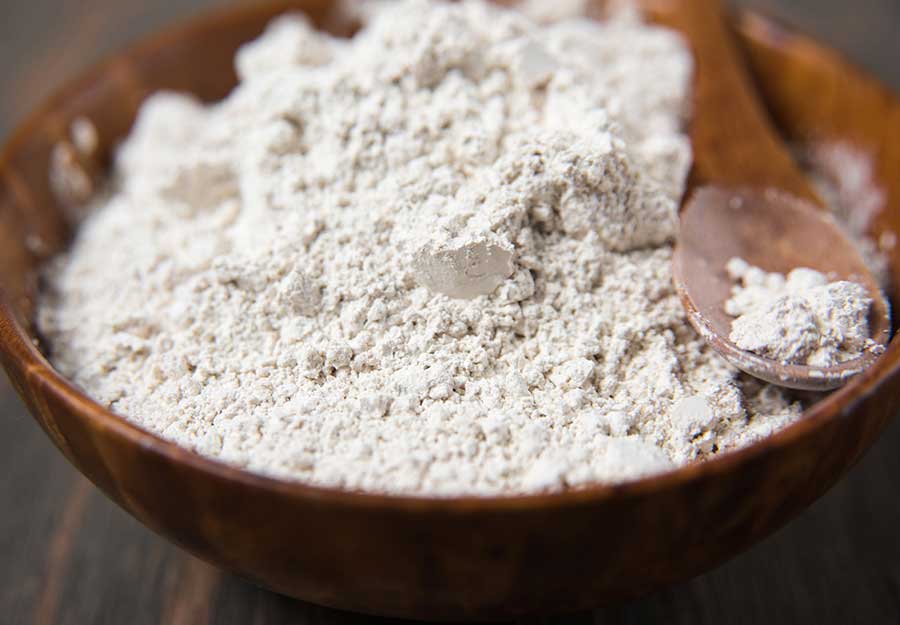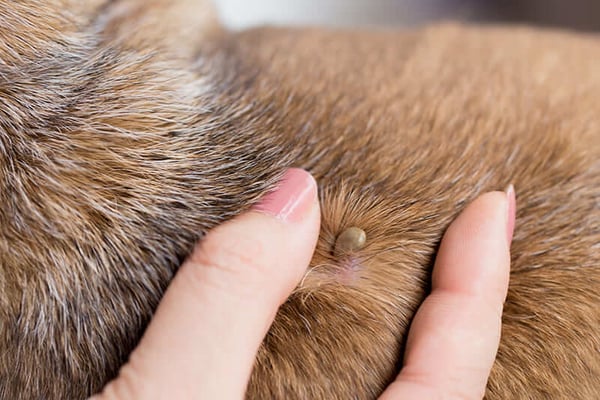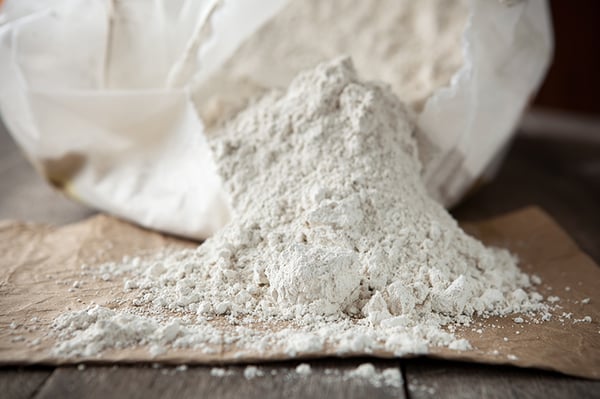
Fleas, ticks, and worms are going to become an issue as we start spending more of our time outside enjoying the warmer weather. If you are looking for a natural way to protect your pet from pests, then check out diatomaceous earth for dogs.
Though many pet pest control products exist, they rely on chemicals like insecticides and antiparasitics. Diatomaceous earth is a natural alternative that mechanically eliminates both internal and external parasites without introducing harsh chemicals into your dogs’ body. How much diatomaceous earth for dogs?
Is diatomaceous earth safe?
(Die-a-toe-may-sh-e-us)
Diatomaceous earth uses for dogs is crushed or ground fossils of single-celled algae, called Diatoms. Their skeletons are made of a natural substance called silica.
Silica, or silicon dioxide, is an incredibly abundant resource, making up over a quarter of the earth’s crust, by weight. It can be easily mined from a variety of bodies of fresh water, from small streams and creeks up to oceans.
There are two forms of silicon dioxide: amorphous and crystalline. Amorphous silicon dioxide is non-toxic, while the crystalline version is. Each is used for different purposes.
Diatomaceous earth food grade is purified to contain a maximum of 0.5-2% crystalline silica. This level is considered non-toxic, meaning it can be ingested safely. For use in pet owners, humans, and gardens, only diatomaceous food grade should be used.
Filter-grade, or non-food grade silica, contains as much as 60% crystalline. This aptly named grade of diatomaceous earth is used primarily for water filtration, like in pools.
How Does Diatomaceous Earth Control Pests?

Unlike a chemical pesticide that damages the central nervous system of the pest, the use diatomaceous earth works on a more mechanical level.
To us, diatomaceous earth looks like a plain white powder, like baking powder, but at a microscopic level, diatomaceous looks like jagged shards of glass.
It’s too small to be harmful to you or your pet, but to an insect, it’s deadly. The sharp pieces will penetrate the protective exoskeleton or outer shell of the insect. Diatomaceous earth is very absorbent, so it will quickly dehydrate the pest by absorbing its natural moisture and oils.
What Type of Pests Can Diatomaceous Earth Protect My Dog From?
Diatomaceous earth for mites on dog can affect most common parasites, but it’s limited by its mechanical function.
For diatomaceous earth to be effective, the pest has to come in contact with the fine powder, so flying pests and pests with long legs, like mosquitoes and spiders, may not be as easily stopped by this natural product.
Internally, parasites like roundworms and hookworms will interact with the powder in the digestive system.
Externally, pests like fleas, ticks, and lice will be affected as they travel across your dog’s body.
Ready to give it a try?
How Do I Use Diatomaceous Earth for Dogs?
Both Baie Run and Wholistic Pet Organics offer food-grade diatomaceous earth supplements designed for pets. So what do you do with this powder? Like any supplement, it needs to be used correctly to be both safe and effective.
Let’s look at the different ways to use this natural pest control aid.
Internally
Like most powdered supplements, using diatomaceous earth is easily added to a food supplement. It can be added to any type of diet but will be more palatable if it’s added to wet food or broth. It has a somewhat chalky taste, so when added to kibble, it might not be the most appetizing supplement.
Here’s a quick reference guide for dosing diatomaceous earth internally:
|
Dog’s Weight |
Dose |
|
Under 30 lbs |
1/3 tsp |
|
31 – 50 lbs |
1/2 tsp |
|
51 – 75 lbs |
1 tsp |
|
76 – 100 lbs |
1 1/2 tsp |
|
Over 100 lbs |
1 3/4 tsp |
Externally
Applying diatomaceous earth topically is a little more work. It’s best to massage the powder onto your dogs’ skin. Less is more, so if your dog looks like Casper the friendly ghost when you’re done, you’ve gone way too far. What is diatomaceous earth good for?
Apply a small amount at a time and rub it in. Add as much as is needed to coat the dog without leaving him looking dusty.
Reapplication will be necessary is your dog gets wet. So, if you are going to be out and about for a while, you may want to keep the diatomaceous earth with you.
Is Diatomaceous Earth Safe for Dogs

Though this natural product is a safe way to treat and prevent pest infestations in your dog, there are still some safety factors that you need to know about before using this product:
- Only use food-grade diatomaceous earth. Any other kind could be toxic to your pet.
- Don’t breathe it. Even non-toxic diatomaceous earth can still be a nasal and lung irritant. When applying topically, try to apply close to the skin in small amounts at a time. This will eliminate the dust cloud.
- Diatomaceous earth is very absorbent, and this can contribute to dry skin. We recommend using a coat conditioner or supplementing with omega fatty acids to moisturize skin and coat. Internally, the absorbency of using diatomaceous earth is a benefit. It can absorb impurities like toxins and heavy metals that can build up in your dog's body over time.
- Stick to pure use diatomaceous earth. Products made for humans may contain other ingredients to act as a more potent nutritional supplement. Products made for pets will generally be just diatomaceous earth, or at least only use ingredients that are safe and approved for pets.
What About Cats?
Diatomaceous earth works the same for dogs as it does for cats, but keep in mind that cats love to groom. If you are applying it topically, consider how much of it your cat will end up ingesting as she grooms.
If you have a multi-pet household, you should also consider how often your cat is grooming your dog.
Natural vs Chemical Pest Control
Although this is an effective product, there is one big reason that diatomaceous earth doesn’t work as quickly as a chemical pest control alternative: eggs.
Many flea preventative and tick treatments, like K9 Advantix, contain ingredients that interfere with growth regulation. They prevent eggs from developing and stop young insects from developing into viable adults.
For diatomaceous earth to be effective, it needs to be used for longer, as the eggs will need time to hatch before the diatomaceous earth can affect them.
Check out all of our pest control products to find the best one to keep your pet safe from pests this summer.
Frequently Asked Questions (FAQs)
What is Diatomaceous Earth (DE) and how is it used for dogs?
Diatomaceous Earth is a natural, sedimentary rock composed of fossilized diatoms, a type of algae. It's commonly used for pest control and can be applied to a dog's coat or environment to help control fleas and ticks.
Is Diatomaceous Earth safe for dogs?
Food-grade Diatomaceous Earth is generally safe for dogs when used correctly. However, it should be applied cautiously, avoiding the eyes and nose, and ingesting large amounts can lead to digestive discomfort.
How does Diatomaceous Earth work for pest control in dogs?
DE works by puncturing the exoskeletons of insects, dehydrating and ultimately killing them. When applied to a dog's coat or bedding, it can help reduce flea and tick infestations over time.
Are there any potential risks or side effects associated with using Diatomaceous Earth on dogs?
While DE is generally safe, inhaling it in large quantities can irritate the lungs, so it's important to use it carefully and ensure your dog doesn't inhale excessive amounts.
What is the correct way to apply Diatomaceous Earth to a dog's coat or environment?
To apply DE to your dog, you can sprinkle a small amount onto their coat, avoiding the eyes and nose, and then brush it in. For the environment, lightly dust areas where pests may hide, such as bedding or carpets.
Are there any alternatives to Diatomaceous Earth for dog pest control?
Yes, there are alternative flea and tick control methods, such as topical treatments, oral medications, and collars. Consult with your veterinarian to determine the most suitable option for your dog's specific needs and health status.
.png?width=200&height=66&name=logo%20(1).png)



.jpg)
